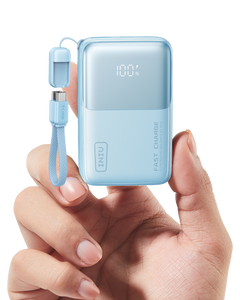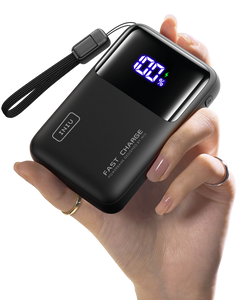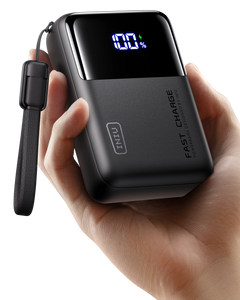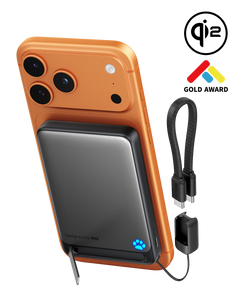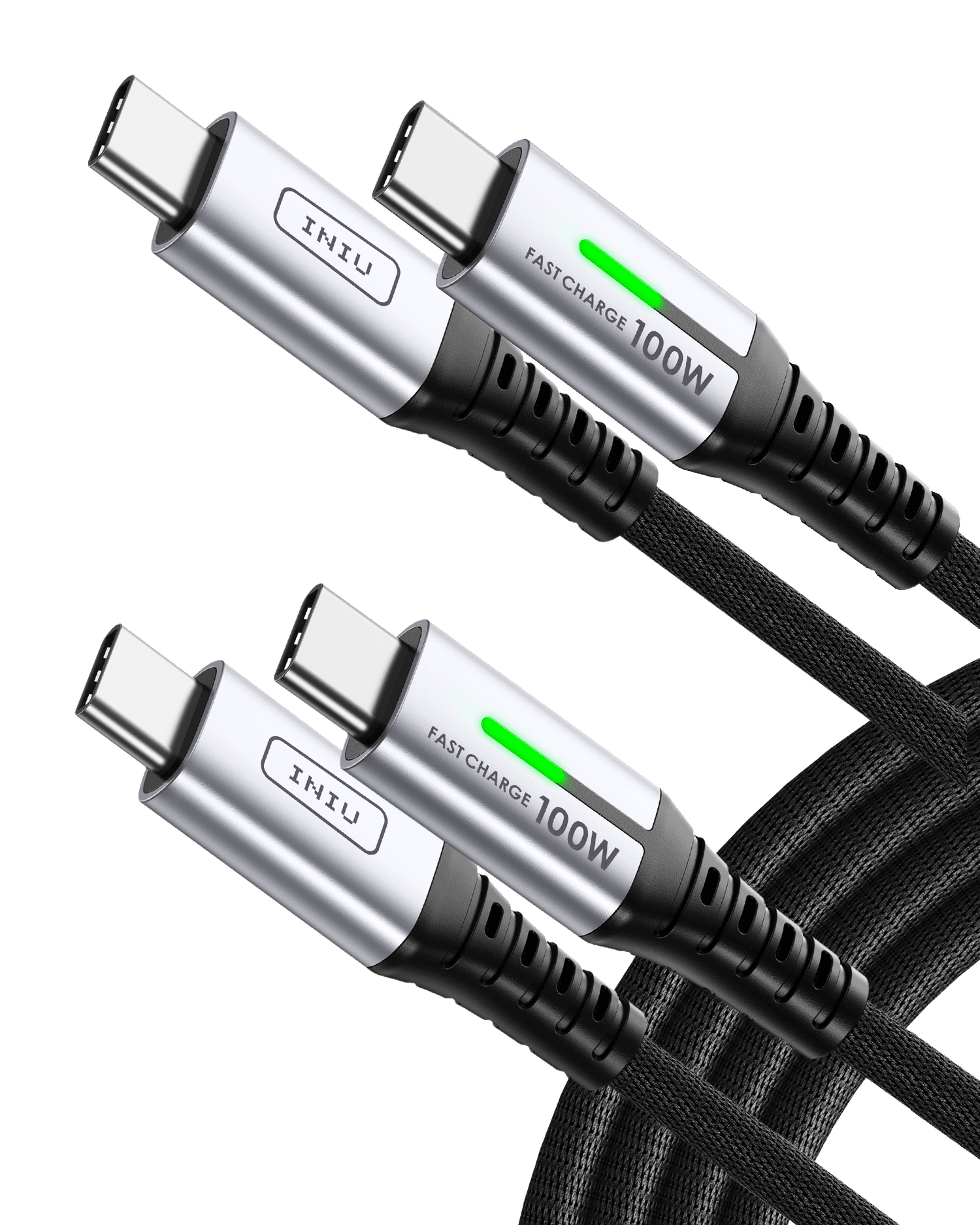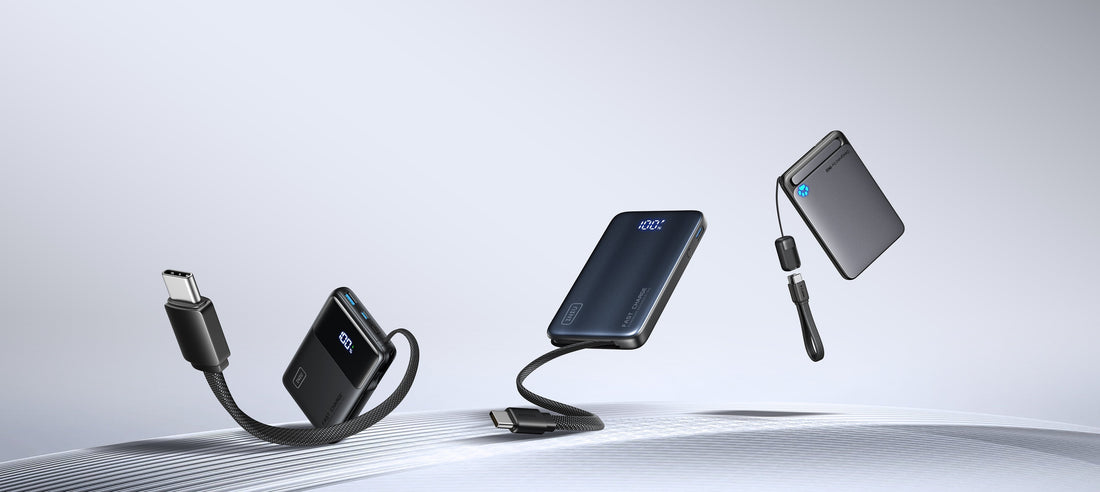
Best Small and Thin Power Banks 2025
People no longer want to choose between portability and performance when it comes to charging. A good power bank should be small enough to slip into a pocket yet powerful enough to keep your phone, earbuds, or even laptop running when you need it most. That's why compact and ultra-thin designs have become so popular—they cut down on bulk while still delivering reliable energy on the go.
In this guide, we'll explore what really matters when choosing a compact charger and break down the differences between small and thin power banks. Along the way, we'll show you specific INIU recommendations so you can find the right fit for your lifestyle.
Key Features to Look For Before Buying

There are numerous power banks on the market. Almost all manufacturers emphasize portability. But what kind of power bank is truly "small" and "thin"? Consider the following key points when choosing.
Size & weight – "Small" should mean genuinely pocketable; "thin" should sit flat in a bag or against a phone. Look for a small footprint and low thickness if carryability is the priority.
Realistic capacity (mAh) vs delivered energy (Wh) – mAh ratings are useful, but remember conversion losses. A 10,000 mAh pack has about 37 Wh of energy; expect ~2 full smartphone charges in real use.
Fast-charge support – USB-C PD, PPS, or Quick Charge protocols determine charging speed. A modern usb c power bank or Type-C power bank should support PD and at least 18–30W for meaningful fast charging; higher outputs help with laptops.
Wireless & magnetic features – If you want cable-free convenience, seek a reputable wireless power bank or the best magnetic portable charger with Qi2 / MagSafe alignment and stable mounting.
Port selection & built-in cabling – Built-in cables (or a detachable cable) are a big win for minimalists; a mini USB charger style convenience means fewer things to lose.
Thermal and safety design – Compact packs must have multi-layer safety: overcharge, overcurrent, short-circuit, and temperature protections. Certifications (CE, FCC, RoHS) matter.
Airline compatibility – If you travel, packs ≤100 Wh are generally allowed in carry-on luggage. A 25,000 mAh (≈92.5 Wh) pack is typically still okay; anything over ~27,000 mAh (≈100 Wh) needs airline approval.
Best Small Power Banks
Small power banks combine pocketability with useful capacity and output. They're the best choice when you want more than a token top-up but still need something you can carry every day.
INIU's small models aim to balance real capacity and useful output in compact housings. They frequently include USB-C PD support, some provide built-in or detachable cables for mini power bank convenience, and maintain safety protections.
INIU P50-E1 — Pocket-first, power-smart
A true pocketable 10,000 mAh option that emphasizes everyday convenience and fast charging. Great as a daily carry mini power bank.
Capacity: ~10,000 mAh (≈37 Wh). ~2.3 full charges for a 3,500 mAh phone (assuming ~80% efficiency).
Output / protocols: Up to ~45W via USB-C PD/PPS for fast phone and light-laptop support. Also supports USB-A output for legacy devices.
Ports & cable: 2*USB-C in/out + USB-A out; comes with a short integrated lanyard USB-C to C cable for on-the-go convenience (mini USB charger functionality).
Size & weight: Very compact and pocketable; designed for one-hand carry. (one of the "smallest power bank" solutions.)
Best for: Commuters, day-trippers, students, and people who want one reliable pocket charger for a phone and earbuds.
Pros: Balanced capacity, compact size, built-in cable convenience.
Cons: Not the ideal choice for heavy tablet or long laptop use.
INIU P62-E1 — Mini but long-lasting
An ultra compact 20,000 mAh pack tuned for users who want extended runtime without a massive brick. Smallest size in its class.
Capacity: ~20,000 mAh (≈74 Wh). ~4.6 realistic phone charges (assuming ~80% efficiency).
Output / protocols: Typical 65W class output on USB-C, suitable for fast phone charging and light laptop top-ups. Supports PD/PPS and multi-device simultaneous charging.
Ports & cable: Multiple ports (USB-C x2 and USB-A in many configurations). No compromise on small-form ergonomics thanks to high-density cells.
Size & weight: Larger than P50 but still compact for a 20k pack. Good pocket or day-bag fit.
Best for: Travelers who want multiple top-ups, heavy phone users, or someone bringing a tablet along.
Pros: Significantly more runtime without becoming a full brick; strong fast-charge support.
Cons: Less pocket-friendly than 10k options; more expensive.
INIU P63-E1 — High capacity in a compact shell
Perfect for users who need near-desktop levels of capacity but still want a smaller footprint than traditional 25k bricks. Supports very high outputs for laptops and larger devices.
Capacity: ~25,000 mAh (≈92.5 Wh). ~5.7 realistic phone charges (assuming ~80% efficiency). Stays under the common 100 Wh airline threshold.
Output / protocols: Up to 100W capability on main USB-C port; ideal for charging light laptops or topping up devices fast.
Ports & cable: Multiple ports for simultaneous charging; best used with quality USB-C to C cables to enable full PD speeds.
Size & weight: Denser but designed to be smaller than many legacy 25k power bricks—good for multi-device days.
Best for: Users who charge a laptop/tablet + phone + accessories and want fewer recharges between wall outlets.
Pros: Exceptional capacity and output for a relatively compact pack.
Cons: Heavier; not pocketable in most shirts.
Best Thin Power Banks
Thin power banks minimize thickness above all else. They are meant to disappear in a pocket or slide into a laptop sleeve next to your device. Many thin models also offer wireless power bank capabilities or magnetic attachments to work as the best magnetic portable charger for modern phones.
INIU P73-E1 — Slim + wireless + solid wired power
A versatile thin charger that marries 45W wired PD output with 15W Qi2 wireless charging — a compelling hybrid for minimalists who want wireless convenience.
Capacity: Typically around 10,000 mAh class (enough for daily top-ups); designed with a focus on slimness and feature set rather than maximum capacity.
Output / protocols: USB-C PD wired output (suitable for fast phone charging) plus 15W Qi2 wireless pad for cable-free juice. Qi2 enables better magnetic alignment and efficiency for compatible phones.
Wireless / magnetic: Works as a true wireless power bank with magnetic alignment so the phone snaps securely in place (best magnetic portable charger behavior). Great for quick cable-free top-ups.
Size / thickness: Extremely slim profile (designed to be a few millimeters thicker than a phone). Ideal to slide into a slim bag or sit behind a phone without bulk.
Best for: Users who want the clean look and convenience of wireless charging and still need a thin usb c power bank for wired speed.
Pros: Hybrid wireless + wired; low profile; excellent for day use.
Cons: Lower max capacity than bulkier options; wireless charging is less efficient than wired.
INIU P71-E1 — The ultra-slim magnetic top-up
INIU's slimmest magnetic charger, aimed at those who want the narrowest possible pack that still supports Qi2 magnetic wireless charging.
Capacity: ~5,000 mAh class—meant for emergency top-ups and everyday light carry. About 1 full smartphone top-up, depending on the device.
Wireless / magnetic: 15W Qi2 magnetic wireless output for secure MagSafe-style attachment and simple one-hand charging. Functions as a true best magnetic portable charger for quick boosts.
Ports & cable: Include a USB-C port for wired charging or recharging the pack itself.
Size / thickness: Extremely thin and light—almost as thin as a card.
Best for: Minimalists, anyone who wants a discreet magnetic wireless backup for short outings.
Pros: Ultra-thin, very portable, magnetic snap-on convenience.
Cons: Limited capacity.
Small vs. Thin: Which One Should You Choose?
Choosing comes down to three questions:
How many devices and how long will you be away from power?
- If you need multiple full charges or to support a laptop, choose a small (higher-capacity) model like the P62-E1 or P63-E1.
- If you want subtle carry and occasional top-ups, choose thin (P73-E1 or P71-E1).
Do you value wireless / magnetic convenience?
- If "snap-on" wireless charging is important, thin magnetic models are built for that. The best magnetic portable charger picks will make cable-free use seamless.
Do you need maximum power vs minimal bulk?
- For higher wattage (65–100W) and multi-device support, look to compact high-output packs.
- For "barely there" carry and a mini power bank feel, thin models are superior.
Finding Power in a Smaller Package

Compact charging is about smarter trade-offs, not blind specs. The smallest power bank that's useful will still offer PD fast charging and multiple ports; the best magnetic portable charger or wireless power bank will combine convenience with solid wireless performance.
Match capacity, output, and form factor to your daily habits, and you'll eliminate battery anxiety without hauling a brick.
FAQ
Q: How many full charges will a 10,000 mAh or 20,000 mAh pack give me?
Using 3.7V nominal and a 3,500 mAh phone as a reference, 10,000 mAh ≈ 37 Wh → about 2.3 realistic charges (assuming ~80% efficiency). A 20,000 mAh pack ≈ 74 Wh → about 4.6 realistic charges. Real numbers vary with device battery size and power conversion losses.
Q: Is wireless charging slower than USB-C wired charging?
Yes—wireless power transfer has higher losses, so wireless top-ups are slower and use more of the pack's energy. Wireless is excellent for convenience and short top-ups; use wired USB-C PD for fastest, most efficient charging. But wireless charging technology is constantly evolving. Standard Qi2 wireless charging can charge devices at speeds up to 15W, while the latest Qi2.2 wireless charging can provide charging speeds up to 25W.
Q: What's the difference between USB-C power bank and Type-C power bank?
None—both terms refer to power banks that use the USB-C connector for input/output. USB-C (Type-C) supports modern fast-charge protocols like PD and PPS.
Q: Are magnetic wireless power banks safe for my devices?
Yes—quality units use Qi2 standards and built-in thermal/overcurrent protections. Magnetic alignment helps efficiency and keeps the phone placement stable. Always choose certified units and reputable brands.
Q: Can I use a mini power bank to charge a laptop?
Only if the pack supports sufficient wattage (often 45W–100W). Thin and low-capacity mini packs typically cannot sustain full laptop loads, but some small high-output models (e.g., P50 with 45W or P63 with 100W) can top up or run lightweight laptops for a limited time.
Q: How should I store a power bank for long life?
Store around 40–60% charge, avoid extreme temperatures, and recharge every 3–6 months if unused. Most lithium packs maintain good life for hundreds of cycles if handled properly.



